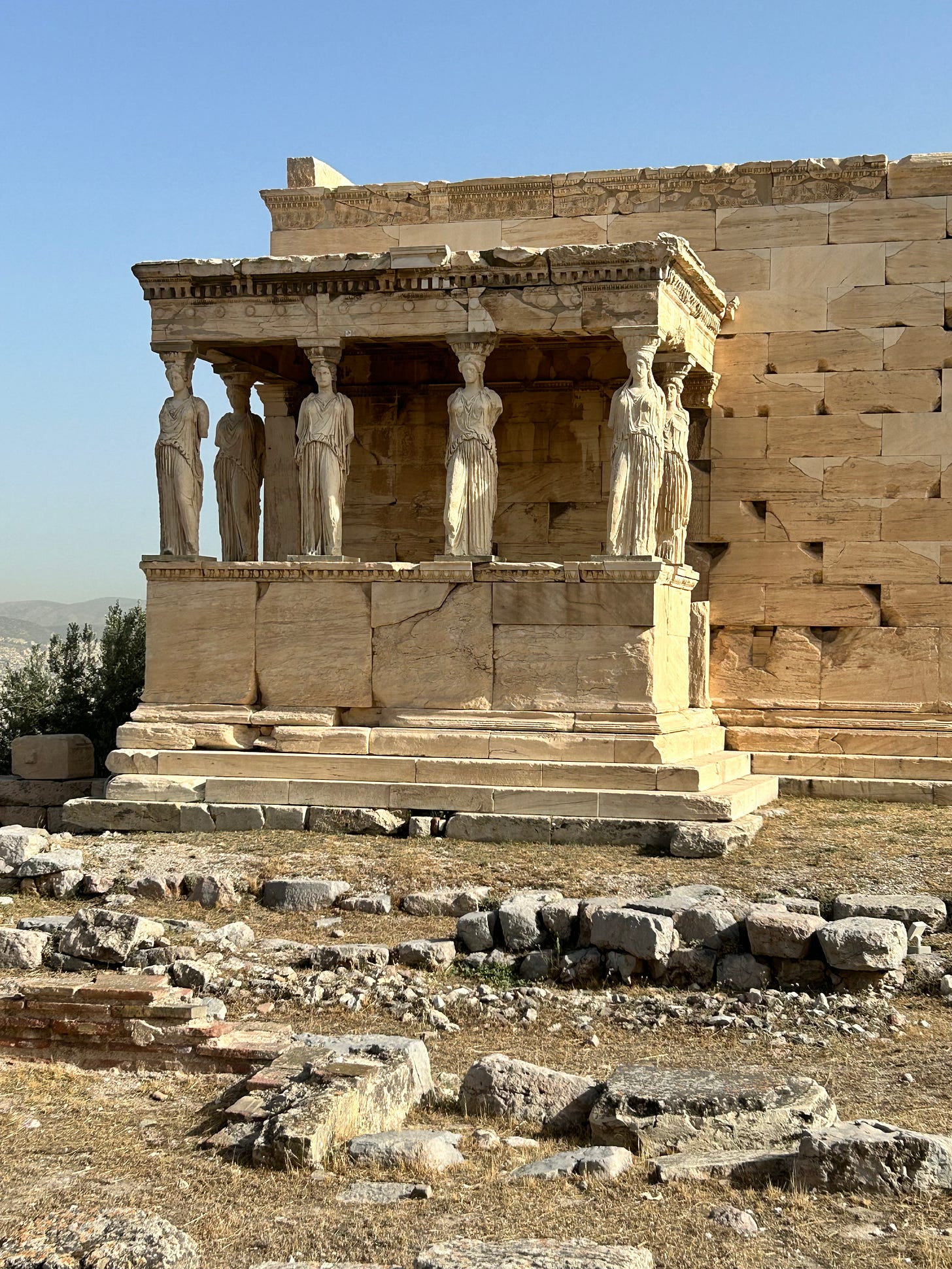There is something haunting about the way the Caryatids stand. Not just graceful and poised, but watchful, like they remember. Like they are remembering us.
Most people know the Caryatids from the Erechtheion on the Acropolis, the six young women standing in place of traditional columns, holding up the weight of the south porch roof. But what often gets left out of their story is the deep and layered connection they hold with Artemis, goddess of the wild, the threshold, and the sacred feminine.
Caryatids and Artemis: More Than Architectural Support
Let’s begin with the name itself. Karyatides, literally “maidens of Karyai.” The town of Karyai in Laconia (southern Peloponnese, already on our list for future Mapping expedition) was home to an ancient sanctuary of Artemis Karyatis, a local aspect of the goddess worshipped in festival and dance. Pausanias (2nd century CE), in Description of Greece (3.10.7), tells us:
“At Caryae is a temple of Artemis Caryatis. Women celebrate a festival in her honour with dances.”
These dances were not mere entertainment. They were sacred acts. Performed by women in her grove, likely near an ancient oak or walnut tree (both sacred to Artemis), the dance was a ritual of embodiment, of fertility, vitality, and collective strength.
This version of Artemis, Artemis Karyatis, reminds us that the goddess was not only a huntress or lunar divinity, but a guardian of thresholds and the power of the collective feminine. The kore, the maiden, was never just young. She was watchful, potent, and prepared. The same readiness pulses through the sculpted Caryatids who hold the weight of the Erechtheion not in struggle, but in silent strength.
In another passage, Callimachus in his Hymn to Artemis (3rd century BCE), praises the goddess for dwelling in “many-pillar’d houses” and being honoured by young girls in dance:
“In the hills and the thick-shaded glens they call thee by many names… Lady of the dance, Artemis Karyatis.”
Even the sculptural stance of the Caryatids, one leg bent slightly forward, the body caught mid-step, echoes the divine dancer, frozen in eternal ritual.
Vitruvius’ later interpretation in De Architectura (1.1.5), claiming that the figures represented enslaved women from Karyai as punishment for rebellion, has long been challenged. His reading reflects a Roman imperialist narrative, not the ritual and religious truths of the Greek past. Today, scholars increasingly interpret the Caryatids as votive, priestly, and sacred in function, more akin to living columns of devotion than to symbols of defeat.
The Lost Sister and the Ones Who Remain
There were originally six Caryatids on the south porch of the Erechtheion. Today, only five remain on site. The sixth was taken by Lord Elgin in the early 19th century and is now held in the British Museum, isolated from her sisters and stripped of her temple context.
Sandra recently wrote a beautiful post about this so-called “Lost Sister”a poetic meditation on what it means to be taken from your roots, your temple, your lineage. I won’t retell it here; I’ll let her words speak for themselves.
Read Sandra’s post here ➝
But I will say this: for those of us who walk the path of Artemis, who listen to ancient stones and the breath of ruined temples, the Caryatids are not silent. They are holding. They are witnessing. They are still here.
Pillars of Strength – Free Online Workshop
June 15, 12–2 PM EST | 9–11 AM PST | 5–7 PM UK
In honour of these sacred figures and the legacy of Artemis Karyatis, I’m inviting you to join me for a special free workshop: Pillars of Strength, part of our ongoing Goddess Wisdom Series. This 2-hour event will explore what it means to stand with strength, to be a support without self-erasure, to be rooted without being bound, to be feminine without fragility.
We’ll reflect, write, move (gently!), and reclaim the archetypal power of the Caryatids and their goddess. This is for all who feel they are holding up too much, or not enough. For those who have lost sisters, or found new ones.
To join:
Sign up for free at The Artemis Centre Learning Platform
Head to the Goddess Wisdom Series section under Experiences
Find Pillars of Strength and click “Confirm Attendance”
It’s free to join, but space is sacred, so please only confirm if you’re truly coming.
If you’re inspired by this work and want to support what we’re building, whether it’s mapping forgotten temples across Greece and Turkey, researching ancient rites, or making goddess-centred education more accessible, please consider supporting this blog, sharing it, or becoming a patron.
You can also purchase my book, She Who Hunts: Artemis, the Goddess Who Changed the World, a heartfelt and scholarly introduction to the Greek Artemis. It’s a great place to begin if you're curious about her history, her many faces, and why she still matters today.
Every offering helps fund fieldwork, content creation, and the long work of restoring her memory, one step at a time.
With strength,
Carla
www.artemisresearchcentre.com
References
Callimachus. Hymn to Artemis. Translated in Callimachus: Hymns and Epigrams, Loeb Classical Library, Harvard University Press, 1921.
Pausanias. Description of Greece, Book 3.10.7. Translated by W.H.S. Jones and H.A. Ormerod. Loeb Classical Library, Harvard University Press, 1918.
Vitruvius. De Architectura (On Architecture), Book I, Chapter I, Section 5. Translated by Morris Hicky Morgan. Dover Publications, 1960.
Stewart, Andrew. Classical Greece and the Birth of Western Art. Cambridge University Press, 2008.
Neils, Jenifer. Goddess and Polis: The Panathenaic Festival in Ancient Athens. Princeton University Press, 1992.
Connelly, Joan Breton. Portrait of a Priestess: Women and Ritual in Ancient Greece. Princeton University Press, 2007.
Dillon, Matthew. Girls and Women in Classical Greek Religion. Routledge, 2002.







